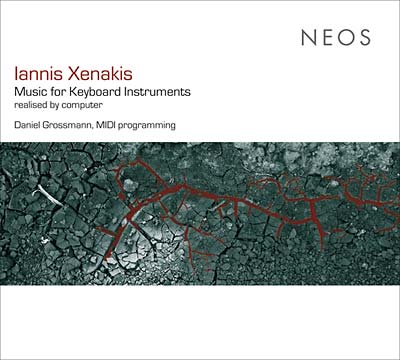XENAKIS, IANNIS - Music For Keyboard Instruments
Pickup available at 1367 Greene Ave
Usually ready in 2-4 days
"Realized by computer. 'Herma' for piano (1961); 'Mists' for piano (1981); 'Khoaï' for harpsichord (1976); 'Evryali' for piano (1973); 'Naama' for harpsichord (1984). Daniel Grossmann, MIDI programming. "This is the first recording of Xenakis' music for keyboard instruments realized by computer -- unplayable by human hands! The desire to hear a composition exactly as Xenakis had in all probability imagined it -- the notation is precise enough -- remains legitimate nevertheless. The conductor Daniel Grossmann presents possibly the first attempt at a reconstruction of the aural imaginings of the composer. The recordings come across as spontaneous, but are in reality the result of intensive work at the computer. And it was precisely in the field of loudness relationships that a plethora of single notes had to be finely gradated. Rhythmic successions of many other single pitches -- ones that produce the aleatoric sound clouds and which Xenakis deliberately notated imprecisely -- had to be pondered about too, in 'Mists,' (3:15-6:30) for example. Achieving a balanced sound within exactly structured textures and articulating optimum relationships of loudness between superimposed but discretely structured layers remain at the center of Grossmann's approach. He also availed himself of the chary use of panorama effects, that is to say, the acoustic distribution of various notes and note groups between the left and right loudspeaker channels, thus making evident the individuality and autonomy of distinct planes of sound. The strict basic pulse and tempo given by the computer have been rendered slightly more 'human,' and are no less the worse off for this. One important aim of his work was, in the end, to garner a convincing dramaturgy within a single work, and thus bring about the optimum rendition of the relationship between the loud and the soft sections as well the best possible lengths of the crescendi and decrescendi. Paradoxically enough, it is just such a computer-aided recording that wholly evinces through its very rationality the enormous liveliness and freshness immanent in the music of Xenakis. A CD recording is not -- well not primarily, at least -- designed for the reproduction of music within a public concert, and is inapplicable to the problem pertaining to the reception of electroacoustic music. The present recordings should be judged on the basis of any normal recording, namely as a documentation of a single act of interpretation with its own artistic claim. This CD must nevertheless be understood not as a substitute for a 'real' recording already in existence or one to be made in the future. The intention is to enhance the reception of the composer's music -- from the audience and performer perspective alike."- Neos.


